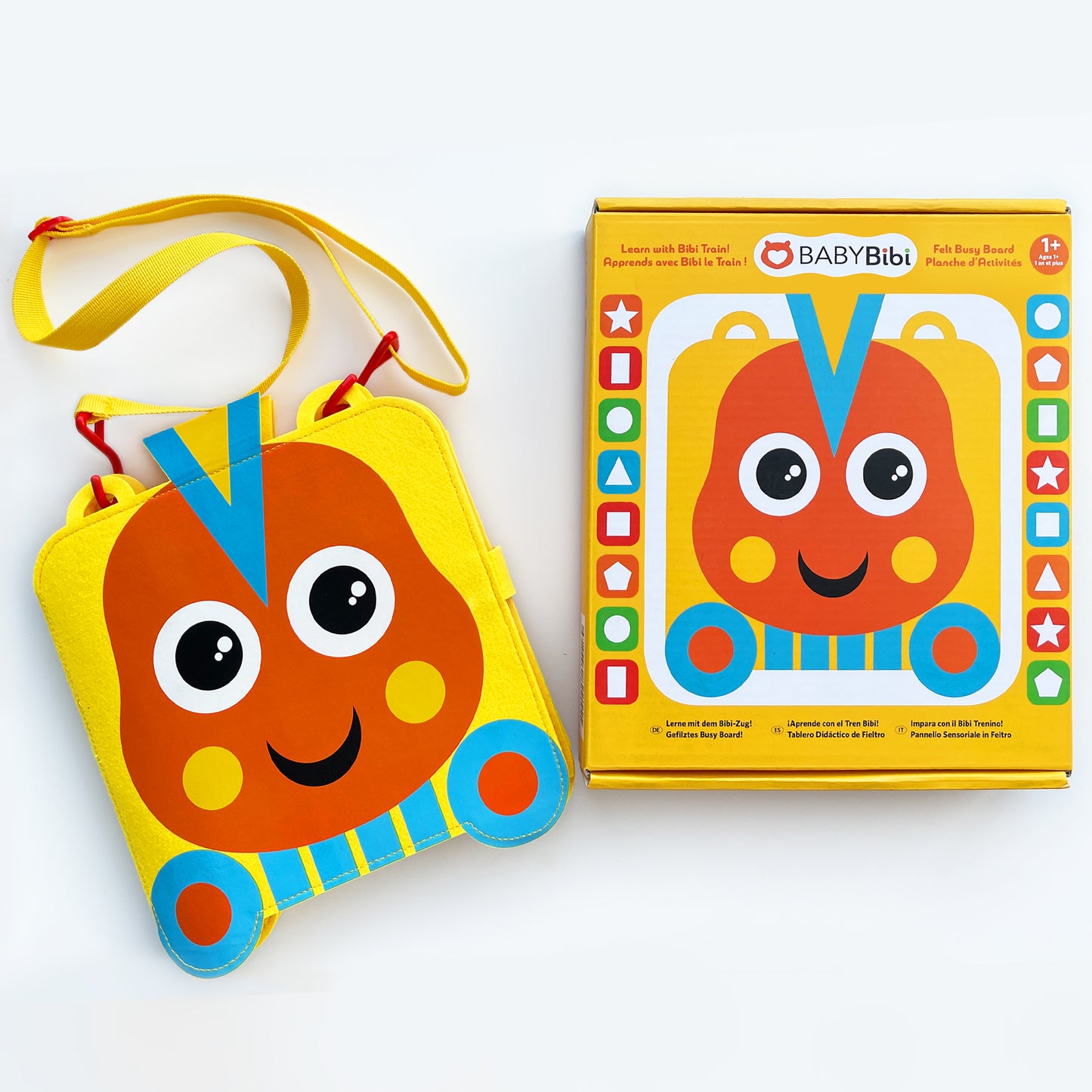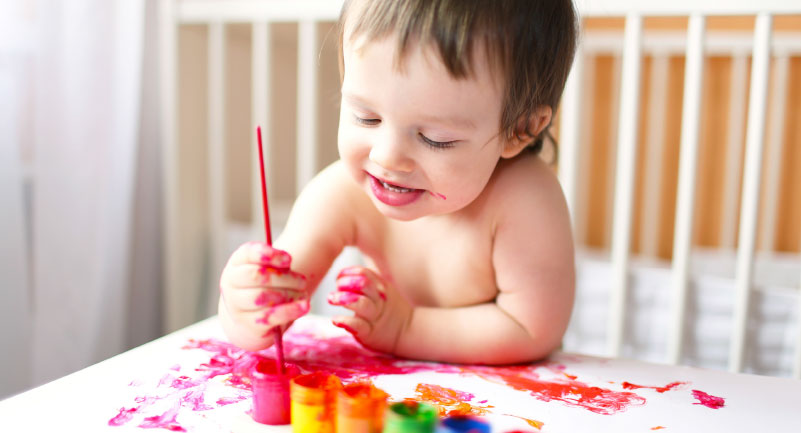Your toddler is 1-2 Years old
Mommy See, Mommy Do!
Infants becoming adventurous toddlers are often attuned to mimicking adults’ every action. Mommy See, Mommy Do! challenges them in this arena with parents being the imitators. While the little ones have de- veloped the art of mimicking to become a great pro cient, adults tend to lack expertise. Nonetheless, Mom- my See, Mommy Do! brings a fresh perspective to parent/child role playing.
With this adventure, the baby will learn self-expression, trust and build self-con dence. When baby vocalizes “ga-gas” and “coos,” parents should reward his or her e ort by repeating sounds. This builds a foundation for improving baby’s conversation skills. Infants principally communicate by making sounds (squealing, coo- ing, crying), body gestures and facial expressions. Mommy See, Mommy Do! supports baby’s developing communication skills and level, which allows parents to properly engage in meaning baby talk.
A recent pediatric study revealed that one-on-one baby talk helps support brain development in young children. At this age, repetition through positive learning experiences is a critical step to accomplish devel- opmental strides. While constructing knowledge, exploring di erent communication styles and building rela- tionships, Mommy See, Mommy Do! provides a platform for free expression. Ultimately, toddlers will devel- op rich conversational and social skills, which improves their ability express thoughts or share ideas.
Where’s Your Nose?
Where’s Your Nose? focuses on rich language development exercises to help toddlers explore sounds, ver- bal expression, and touch. It’s a great activity that 1 to 2-year-olds will de nitely. This Where’s Your Nose? singalong will get toddlers reciting the song in a wink. This melodious sing-along will get toddlers giggling so hard. While singing a parent or caregiver should gently touch the kid’s nose and shout, “There’s your nose!” When they’ve learned the nose, parents should include other parts of the body. Another smart concept is to include objects and other properties that are easily visible. It’s a fantastic idea to get kids to explore their surroundings. Besides learning about body parts and objects, children will take away vocabulary building skills. They’ll enjoy word exploration and expand their vocabulary with repeated exposure to “There’s your nose!”
With toddlers getting ready to receive a formal education, they’ll greatly bene t from early exposure to lit- eracy and building vocabulary. Studies show that children who develop a vast vocabulary tend to be ad- vanced thinkers and problem-solvers. What’s more, children who develop stronger vocabulary skills be- come better readers. Literacy and language experts have described them as ambitious academic achievers as well.

Pom Pom Party
How about recycling plastic cups, markers, old magazines, paper, paper money, ice cream scoop and pom poms? Toddlers have a huge appetite for imagination. Pom Pom Party gets them on the wild side. This ac- tivity focuses on building math skills with meaningful sensory exploration. It also helps children learn the value of teamwork and socializing. Infants and busy toddlers both enjoy Pom Pom Party activities.
They’ll learn how to count properly. Money counting (coins) is a fundamen- tal lesson that will help children practice math. This Pom Pom Party activity challenges children’s imagination with pretend eating, playing and counting exercises. Children ages 1-2 years tend to become curious explorers as they’re discovering objects, places, and things. Young kids fancy ice cream, no matter their age. When kids want to spend their Pom Pom Party coins, a pretend play ice cream parlor has awesome activities for them to try. With this cre- ative activity, children will learn how to do crafts such as paper money and making ice cream. It helps them to bring ideas and thoughts into reality. What’s more, toddlers will enjoy socializing and become an e ective team players. Pretend play exercises can be played with siblings, parents or friends. It’s a great party activi- ty for children too.
Rhyme Time
Whether it’s a poem or nursery rhymes, kids are quick to chime in and show o their singing talent. While it’s not traditional karaoke, Rhyme Time gets the kids singing. Toddlers enjoy hearing their parents sing es- pecially when it is a repetitive song they can easily learn. This Rhyme Time game is perfect when kids are bathing, out for a ride or enjoying quality snuggling with parents. How will kids bene t for Rhyme Time? It’s practical for parents to wantto keep their young ones entertained. Rhyme Time encourages language de- velopment in younger children. Language and speech development are foundation skills achieved by one- year-olds. Early language stimulation is an integral tool to helping a child communicate better. Additionally, Rhyme Time helps them understand feelings and enhances their ability to express thoughts.
Toddlers love the rhythm of rhymes, especially how it rolls o their tongue and leave the ears tickling. Dr. Seuss world of books o ers soothing selec- tions that tots will love. Rhyming games and activities prepare toddlers for reading and improve their vocabulary skills. So let the little tots enjoy Rhyme Time favorites like Patty-Cake, Itsy bitsy Spider and more. A creative way to introduce illustrations when playing this game is to add kid’s friendly magazine images or stickers that complement nursery rhymes.
Build It Up!
Tots should get adequate play time to build things and express their creative side. Build It Up! activities take their creative minds on a new journey with toilet paper rolls. These reusable materials are perfect for indoor or outdoor Build It Up! activities. From sculpting to decorating, this activity helps the little ones ex- press their artistic talents.
Glue or tape is needed to bring bits and pieces together. Parent supervision is highly encouraged when tod- dlers are using scissors. Tots will enjoy cutting out various shapes and decorate toilet paper rolls. Preschoolers can choose tape or glue to hold stickers and shapes to the rolls. Another Build It Up! activity idea is to construct colorful structures (skyscrapers, towers, etc.) using toilet paper rolls.
This activity helps children shape their development into becoming creative thinkers and problem solvers. Build It Up! Challenge is recommended for both toddlers and preschoolers. In a social environment, kids are exposed to working as part of a team chasing a common goal. They’ll also be involved in physical development exercises that enable them to improve gross and ne motor skills.

Easter Egg Hunt!
Isn’t the Easter holidays a great time for families to enjoy themselves, especially the little ones? They’re al- ways excited about Easter Egg activities. With plastic eggs, pen and paper wrappings, it’s worry-free to orga- nize an event kids won’t forget. In fact, they’ll look forward to an annual party or spontaneous adventures of Easter Egg Hunting. Having a reward system in place will motivate their participation and keep them interested. This adventure involves physical development activities that will strengthen their muscles and bones. Even if it’s not Easter, preschoolers will still enjoy themselves singing nursery rhymes, doing the bun- ny hop and jumping.
Playing Easter Egg hunt don’t require the skills of a rocket scientist. The host (parent, teacher, caregiver, etc.) will prepare all the Easter eggs (plastic) and hide them. Any child who has successfully performed all actions correctly, doing the bunny hop, jumping ten times and singing a favorite nursery rhyme will win a prize.
The game host can determine how long the activity will last. It can typically last anywhere from a few min- utes to hours depending on the crowd and challenges involved. It’s an interesting way to introduce founda- tion Mathematics to younger children. Additionally, Easter Egg Hunt provides a platform for preschoolers and toddlers to improve their language skills. While expanding their vocabulary, children will bene t from literacy/language development, learn social/communication skills and enhance motor skills.
Toilet Roll Stamps
This is another activity that teaches children how to recycle used materials. Toilet rolls have many uses when creating reusable crafts for children. Activities centered on recycled craft projects let children use their imagination as much as possible. It’s no di erent when they’re creating toilet roll stamps. Is Valentine’s Day fast approaching? Kids can use toilet rolls to design heart -shaped stamps to celebrate Valentine’s Day or make some awesome arrangements. They’ll need a couple of items for this activity such a blank sheet (large paper), a plate (paper) for palette, paint and empty toilet rolls (tubes).
If they’re making heart-shaped Val- entine’s Day patterns with the tubes, they will need all their strength for squishing the rolls and manipulating it to form the desired shape. It can be used as wrapping paper or for creat- ing greeting cards.
They can also squish one end of the toilet paper tube to form the desired shape, for example, a heart and dip it into a plate (palette) lled with paint. Making toilet roll stamps isn’t a demanding exercise and children usually enjoy the activity. It’s an awesome gift for Christmas and birthdays too. As individuals, kids need ac- tivities like this one to unlock their creative skills and nd a hobby.
Traveler’s Alphabet
Kids quickly become fans of Traveler’s Alphabet. The game is geared towards toddler’s age 1 to 2 years. It’s the simplest form of educational activities to train their developing brain. What’s more, Traveler’s Alphabet motivates them to learn letters and improve accuracy. While many toddlers are familiar with the alphabet, they’ll miss a letter or two. With rich exercises that en- courage imaginative play, they’ll learn how to build upon ideas and process images while interpreting sensations without immediate sensory input.
So what’s Traveler’s Alphabet really about? Each player should complete the sentence: “I’m going on journey to___.” Kids should know the alphabet to win the game, so it’ll be an enriching practice exercise for children of all knowledge levels. It’s required of each player to use a word describing a place that starts with letters
A to Z depending on the progress of the game. If the player has nished the sentence correctly, they’ll move on to the question: “What will you do there?” Again, the player should answer this question correctly with an activity that begins with the matching letter.
Players who fail to provide accurate answers are eliminated and the game continues until one player is left standing. He or she will be declared the winner. Kids tend to become fussy when they’re eliminated, so the host can allow up to 3 chances to avoid tantrums.


